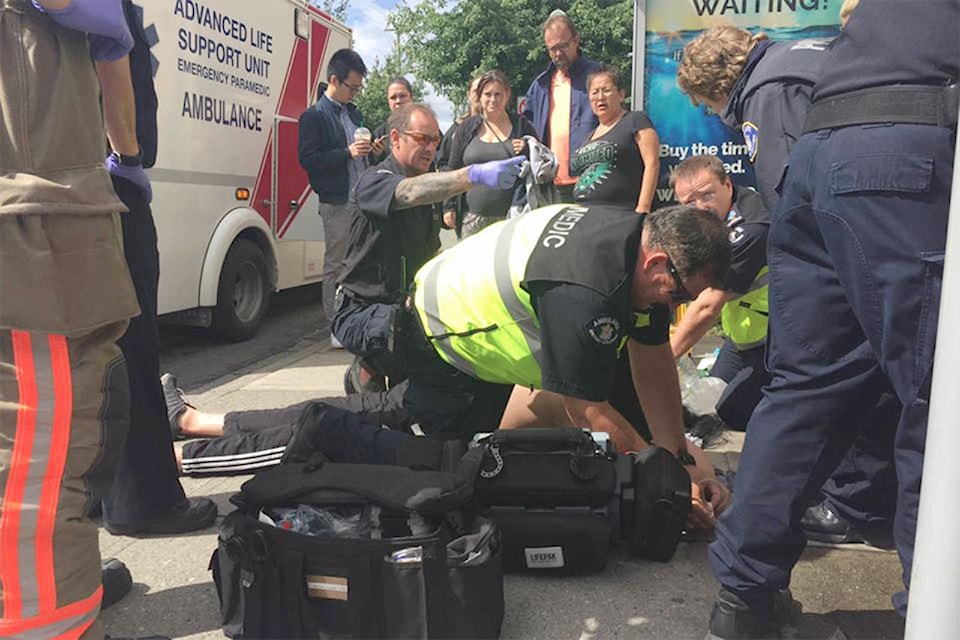Recent data from the First Nations Health Authority shows intergenerational trauma and unsafe or unavailable health care has meant that First Nations people have been killed by toxic drugs at more than five times the rate of others in B.C.
Unequal responses to COVID-19 and the toxic drug crisis “have had a significant negative impact on toxic drug overdoses and deaths overall, especially for First Nations people in B.C.,” said FNHA acting chief medical officer of health Dr. Nel Wieman, who is Anishinaabe from the Little Grand Rapids First Nation in Manitoba.
Wieman said the combined forces of racism and misogyny create particularly high risk for First Nations women, who are nearly 10 times as likely to die of toxic drugs than other women.
Toxic drugs killed 176 people in April, putting British Columbia on track to record more than 2,000 deaths this year and see 2021 become its second consecutive most deadly year.
In the first four months of 2021, 680 people have died, 64 per cent more than the 390 deaths in the same period last year.
An average of about six people died each day in April, which was the province’s 14th month in a row with more than 100 deaths.
The data showing a widening gap in death rates between First Nations and others came the same week as the Tk’emlups te Secwépemc announced the nation had located the remains of 215 children in unmarked graves at the Kamloops Indian Residential School.
Green MLA Adam Olsen said residential schools and the toxic drug crisis are “inextricably linked.”
Olsen is a member of the Tsartlip First Nation on the Saanich Peninsula and represents Saanich North and the Islands for the BC Greens. His grandparents and many relatives were forced to attend Kuper Island Residential School near Chemainus.
The Greens called for an emergency response to the overdose public health emergency using “as much as is necessary” of the province’s approximately $3.1-billion contingency fund to implement safe supply and to create a cross-party committee on ending the crisis.
“We’ve talked about the emergency but not acted with the urgency,” said Olsen, who called on the province Monday to take immediate action to fund Indigenous supports and services.
The number of deaths continue to increase nearly nine months after the province promised an expansion to safe supply efforts in September, work it said is now in the hands of the medical community.
Minister of Mental Health and Addictions Sheila Malcolmson said in the legislature there was still more to be done, and that the province has been expanding treatment beds, particularly for youth.
Olsen said it is clear the province needs to change course and provide the resources to end the toxic drug crisis that is disproportionately killing First Nations people.
“`Just the way it has always happened’ is going to have to change, because what has always happened is breaking us,” he said. “We as a province need to stop undervaluing Indigenous lives.”
Experts, advocates and people who use drugs have long said that safe and regulated supplies of now-illicit supplies are the best way to stop deaths in the short-term while culturally safe and evidence-based treatment and recovery options are expanded.
Chief Coroner Lisa Lapointe, whose office is conducting a “systems-level” death review panel on toxic drug deaths, said immediate action needs to be taken while a comprehensive and culturally safe system of care is built.
“What we need in this province is a shift in velocity,” Lapointe said in an interview. “It will take time, but this is urgent. People are dying because we don’t have a supportive system in place.”
Meanwhile, the City of Vancouver submitted its final application to the federal government today seeking approval to decriminalize personal possession of some substances including opioids and cocaine, as well as MDMA, psilocybin mushrooms and benzodiazepines.
The model, which seeks an exemption from Ottawa from the Controlled Drugs and Substances Act, aims to reduce the harms of criminalization and connect people to health care, with no mandatory administrative or financial penalties. Drug manufacturing and trafficking would remain illegal.
But drug user advocacy groups have said the threshold amounts established by the city and the Vancouver Police Department are unrealistic, don’t reflect current use needs and patterns and won’t bring real decriminalization.
“Thresholds are a ridiculously archaic way of thinking you’re trying to somehow regulate how police interact with people,” Karen Ward, a drug user, Downtown Eastside resident and advocate, told The Tyee last month.
Decriminalization, which provincial health officer Dr. Bonnie Henry has repeatedly called for, also doesn’t change people’s dependence on the toxic illicit supply, which is why advocates say it must go hand in hand with safe supply to save lives.
Henry and Wieman agreed last week.
“We need to advance the calls that we put out from our office for several years around decriminalization,” said Henry. “We need to create a safer drug supply and that is one of the things we continue to push.”
— Moira Wyton, Local Journalism Initiative Reporter , THE TYEE
RELATED: Vancouver sends drug decriminalization pitch to Health Canada for federal review
RELATED: First Nation MLA says B.C. must do more for reconciliation after residential school deaths
